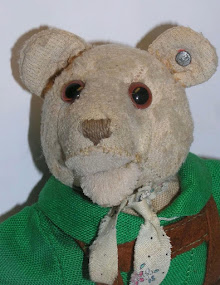Does this great Steiff Santa doll strike a chord with you? Check out this unusual holiday hero with a very special feature - he's musical! Have you ever seen another one like it? A friend from Pennsylvania shares...
We bought this 15" Steiff with a music box key wind in the sack. The music box is in the sack attached to his back with a large key protruding from it. I would love to know anything you can tell me about it. Thank you!Well, let's warm things up with what we know about this friend from the North Pole. The doll itself is based on the company's legacy midcentury Santa doll pattern introduced in 1953. This earliest Santa doll was 31 cm and five-ways jointed. He had a rubber head, felt body, bright red felt suit and cap trimmed in white mohair, and a white, fluffy mohair beard. By 1955, this design was also produced in 13 and 18 cm. These Santa dolls appeared in the line through 1963 and were, and remain, year-round favorites with collectors worldwide. The Santa under discussion today measures 15" tall, or 38 cm, so he was probably not part of Steiff's standard line Santa production. His larger size suggests he was a special order, perhaps intended as a seasonal window or mantel display.
Now let's tune into his musical feature. With full disclosure that Steiffgal has not handled this item in person and inspected for originality, she can suggest two possible origins for his music box.
First: Given that the music box is located in his sack, and not in his torso, it is possible that it is not Steiff original to him and was placed there by a previous owner. The music box is described as having "a large key." Every wind up music box Steiffgal has handled has a very small, simple turning knob. It's size hints that the music box may not be Steiff original to him. Just about every musical Steiff item Steiffgal can think of from any era has its musical feature embedded in its body - probably to secure it in place, as well as to protect it against bangs and bumps. For example, the musical Basi pictured to the left has her music feature in her bottle shaped body; it is activated by pressing her up and down. As Steiff's midcentury Santa dolls were not distributed with a Santa sack, it wouldn't be that challenging to make one, put a wind up music box in it, and sew it to the doll's body. That would be MUCH easier than opening up the doll, removing stuffing, inserting a music box, and sewing everything up seamlessly.
Second: It is also possible that the musical feature is all original to the doll. Most Steiff collectors are familiar with the company's standard line musical Cockie Cocker Spaniel, Teddy Bear, and cat patterns. These were all produced in the mid to late 1950s. However, Steiff also produced a number of other uncatalogued musical rarities based on beloved 1950s era designs, including their Lulac rabbit and lying tiger. "Music Tiger" is pictured here on the left. Given the timeline and popularity of the 38 cm doll design under discussion here, it is not out of the question that the company tried to make a musical Santa Claus doll, too; maybe even in a distinctly larger size. Perhaps the musical machinery was too large or strangely shaped to bury it in the doll's torso so the designers made a sack for him, and hid the music box within it. If the Santa sack is elegantly constructed from period fabric, matches the look and feel of the doll, and has aged in tandem with the rest of the overall doll and clothing, this would suggest that is factory original to the doll. But, in the end, only Santa knows for sure... and he's keeping tight lipped over this!
Steiffgal hopes this discussion of this musical Santa Claus has wound up your interest in this unusual doll.
Have a question about one of your Steiff treasures? Let's talk! Click here to learn more.


















